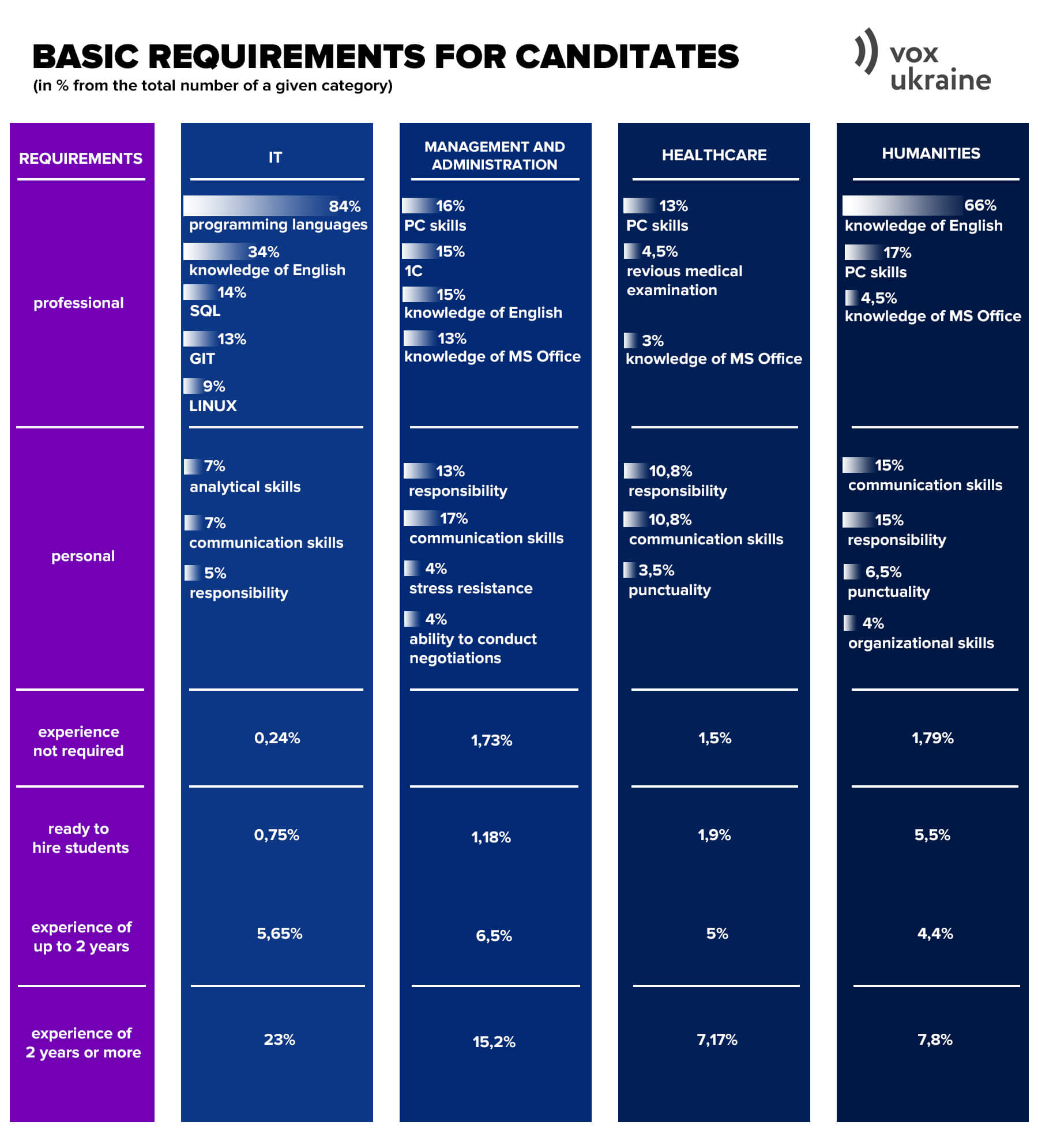With the quarantine lifting stages working as planned by the Cabinet of Ministers, the 2020 admission campaign will begin at the end of the summer. More than 350 thousand school graduates will have the external independent evaluation choosing their future occupation. Which departments are most frequently chosen by the entrants and does the popularity of these areas meet the demands of the labor market?
Choosing a future profession is a responsible step, because it will shape a person’s future in one way or the other. It is quite likely to influence the speed of employment and starting salary. Especially, since most students get higher education specifically to increase their chances of landing a better job in the future.
Which professional areas are the most popular among school graduates and which in the labor market? VoxUkraine analyzed more than 822 thousand vacancy announcements and compared them with the statistics of admission campaigns in 2018 and 2019. We identified the specialists in short supply in the labor market and the employers’ requirements for those specialists, expectations of a higher education diploma, and readiness to hire someone with no experience. At the same time, we identified the most popular professional areas among future students. Are there differences in supply and demand in the labor market and higher education?
The main conclusions
- The most popular areas with both employers and entrants are Management and IT.
- The third most popular area among students is Humanities. 9% of entrants applied for it in 2019 (on the other hand, such education is found in 1.7% of vacancy announcements). Healthcare is third in terms of the number of employers’ job ads (8.69% of ads and 6.7% of entrance applications).
- Among the requirements for specialists in the most popular areas, special attention is paid to soft skills, i.e. communication skills, responsibility and punctuality.
- Technical skills requirements, other than in IT, are usually limited to being a confident PC user, knowing MS Office or 1C. 2.7% of job ads clearly state their readiness to hire job seekers with no experience.
- Salaries can only be an incentive for entrants in the field of IT, since they are not above the national average in other industries (however, the salaries specified in job ads can be understated).
See the detailed methodology at the end of this article.
Managers and IT specialists
It is quite difficult for young people to get a job. Unemployment among young people aged 15-24 in Ukraine averaged 19.5% over the last 5 years, with the overall figure for the entire population aged 15-70 remaining at an average of 9%. This may be partly due to the mismatch between the market demand for certain professionals and education areas chosen by the majority of applicants. In other words, future students do not opt for professions that are in demand in the labor market.
We selected the top 5 areas of education the students mostly applied for in 2018 and 2019, comparing them with the top 5 vacancies by the number of job ads on Jooble. As they intersect in three positions, we have the top 7 vacancies in both directions in the charts below.
The students’ preferences and employers’ requests do not differ much. During 2018-2019, Management and Administration and IT were in the lead both in terms of the entrants’ preferences and employers’ requests (Fig. 1).
Fig.1 Comparison of the share of job vacancies and professional specialties in the most popular areas
Management and Administration
In the last two years, the largest number of entrants sought training as a manager. In 2018, 13% of entrants chose Management and Administration, with their number being even higher in 2019 – 14.8%. This category includes several specialties, the most popular of which is Management proper. In 2019, the latter had 54,396 applications, which is 10% more than in 2018 (49,022).
Such popularity meets the market demand. Sales managers are sought for in 19% of all vacancy announcements.
However, in 2019, nearly 4 times less entrants (14,063 applications) applied for the most sought-after occupation of accountant (20% of vacancies) than for Management.
IT
The pace of the IT industry’s development attracts applicants. In this area, future students submitted 11.8% of admission applications in 2018 and 12.5% in 2019. The most popular specialties in this field were Computer Science (39,445 applications in 2018 and 39,908 in 2019), Software Engineering (26,700 and 27,518 applications), Computer Engineering (17029 and 16,769 applications) and Cybersecurity (15,506 and 16,429 applications, respectively).
Such specialists are among those in highest demand in the labor market. Of over 822 thousand job ads, a third searched for IT specialists. At the same time, here demand exceeds supply, and the vacancies’ growth dynamics are impressive. In 2019, the number of vacancies for IT specialists (136,275 or 35% of the total number) was 30% higher than in 2018 (105,157 or 26.5% of vacancies).
Healthcare vs Humanities
There is a significant difference between the students’ preferences and the employers’ expectations with regard to the third position in both rankings. While there is a shortage of health professionals in the labor market (9% of vacancies), students opt for Humanities.
10.9% of entrants chose Humanities in 2018 and 9.6% in 2019. Humanities gained such popularity due to Philology, the leader among all training areas in terms of the number of applications in 2018 (78,571), being second in 2019 (67,012).
The chances of finding a job if you applied for Humanities are not so high. Education in this area is specified in only 1.7% of vacancy announcements, with foreign language teachers (5024 or 36.5% of vacancies) and translators (3941 or 27% of vacancies) being among the most sought after. Despite this, the state order in this area amounted to 4,664 seats (5.9% of the total) in 2019.
Entrants, as well as employers, were mostly interested in professional specialties falling under Management and Administration and IT. Employers are mostly searching for managers, accountants and IT professionals. The same occupations are included in the top 3 choices for entrants. However, Humanities, that are rarely seen in job ads, are third in the entrants’ ranking. By contrast, healthcare professionals are third in terms of employers’ request. Read on about the employer’s requirements for the most popular professional specialties.
Basic requirements
We selected vacancies in the most popular areas according to employers (Office, IT, Healthcare) and students (Office, IT, Humanities) and looked into the employers’ requirements for these professional areas, higher education and desired skills. We also identified job vacancies requiring work experience and those where employers are ready to hire students.
Fig. 2 Basic requirements for candidates

Since the selected professional specialties differ greatly in functionality, their common requirements are the so-called soft skills. These are the skills of interaction, working within a team and sociability. That is, they relate to functional literacy that includes communication and social skills, as well as “the ability to understand, evaluate, use and deal with written texts to participate in public life, achieve goals and develop knowledge and potential.” Vacancy announcements often specify sociability among such skills.
Communication skills are most commonly seen in the requirements for one of the most popular areas – Management and Administration, in 17% of vacancy announcements. Specifically, applicants are expected to be:
- communicative (17% of ads),
- responsible (13% of ads),
- able to conduct negotiations (4% of ads)
- stress-resistant (4% of ads).
Higher education is specified in 30% of job ads for management professions. Among the specific skills are 1C (15% of ads), PC skills (16% of ads) and knowledge of English.
Most employers are not ready to hire students or people with no work experience. The share of ads where work experience is optional is 1.73%, with vacancies for which they are ready to hire students being only 1.18%. In the majority of job ads (15.2%) for management positions, employers require work experience of two years or more. 6.46% of ads in this area expect the minimum work experience of up to two years.
The vacancies in the popular IT area have the largest list of specific requirements. They depend on internal specialization, so we identified the most common ones, such as:
- programming languages (84% of ads),
- SQL (14% of ads),
- GIT (13% of ads),
- Linux (9% of ads).
Knowledge of English is specified in 35% of IT job ads, with half of them expecting intermediate/upper intermediate level (18% ads). Analytical and communication skills are required in 7% of announcements, and responsibility in 5%.
It will not be easy to get a position in IT with no work experience. There are almost no job ads where experience is not required (0.24% of ads) and where they are ready to employ students (0.75% of ads). The majority of ads (23%), where work experience is separately indicated, expect it to be more than two years. With work experience of up to two years, you can try to apply for 5.65% of the job vacancies listed.
The third most popular area among students is Humanities that got 9.56% of entrance applications in 2019. Compared to the other popular training areas, higher education is most often specified in this area – in 34% of job ads.
Among other requirements in this area, job vacancies pay a lot of attention to soft skills, namely:
- communication skills (15% adds)
- responsibility (15%)
- punctuality (6.5%)
- organizational skills (4%)
Among the professional expectations, the most common is knowledge of English, with 17% of ads specifying PC skills, in 4.5% of which knowledge of MS Office is specified separately.
It is easiest for students to find employment within the category of Humanities (in 5.5% of job ads in this area, employers are ready to hire students). Ads specifying a minimum work experience of up to two years are not much less – 4.4%. 7.8% are looking for experienced specialists with two years of work experience. Only in 1.8% of announcements, work experience is optional.
The employers’ top 3 vacancies include Healthcare (8.69% in 2019). Since this area is the fourth most popular among students, we looked into its requirements.
Among the five most popular requirements for healthcare professionals, three relate to personal skills. The most anticipated among them are:
- communication skills (10.8% of ads),
- responsibility (10.8%),
- punctuality (3.5%).
It is interesting to note that no specific requirements with regard to professional skills are included among those specified most frequently in the vacancy announcements. But potential employers often expect a preliminary medical examination (4.5% of ads), probably, to reduce the time it takes for the applicants to take up their duties.
Higher education in this area is specified in vacancy announcements a little less frequently than in Management and Humanities (21.6% of job ads).
Employers mostly search for candidates with up to two years of experience (5.4% of the ads specifying work experience) and more than two years (7%). They are ready to employ students in 1.89% of ads. Experience is not important in 1.46% of the ads where it is specified.
Communication skills are often seen among the vacancy requirements in the most popular areas. Higher education is most often specified in job ads in Humanities and Management. Most often, employers specify in their ads the expected work experience of more than two years.
Salary expectations
One of the factors in choosing a profession can be the level of future salary. Therefore, we checked the salary levels for the most popular job vacancies and occupations and compared them with the average value calculated according to data from Jooble. In calculating the indicators, we ignored the salaries below the minimum wage (UAH 3,700 per month in 2018, and UAH 4,100). If a job ad specified a salary range, its lower value was used. For salaries in foreign currency, their hryvnia equivalent was calculated at the NBU exchange rate on the day the vacancy announcement was published.
Job ads seldom specify the level of salary. Of the 822,805 vacancies in the sample, only 36% specified wages.
Overall, the salary in the job ads may be understated, normally specifying the minimum or starting level. Interestingly, in 2019, the average salary on Jooble (UAH 11,101) was not much higher than that reported by the State Statistics Service (UAH 10,497). In 2018, the average salary on Jooble (UAH 10,250) exceeded the average official salary (UAH 8,865).
Fig.3 Salaries in the seven most popular vacancy and study areas *click on the year for comparison and point to the chart for details*
IT, Management and Administration, Humanities, Social and Behavioral Sciences, Jurisprudence, Education/Pedagogy, Healthcare
The highest salaries are in IT, as expected. They exceed the average value more than twice: UAH 25,000 against the official UAH 10,497.
Specialists in Management can expect a salary of UAH 9,000 (UAH 1,000 higher than last year). Salaries in other areas are even lower.
Healthcare is third in terms of staffing needs. However, the average salary in this area, UAH 5 thousand, is the lowest among the popular areas, being twice less than the average official salary. It has not changed compared to 2018.
A slightly higher salary is specified in Humanities – 7,000 UAH in 2019 – which is 36% less than the average salary calculated according to data from Jooble.
We checked for a relationship between the salary level and the number of job vacancies, and between the salary level and the number of applications for each of the 29 professional fields. We found no relationship between the number of applications and the level of salary. There is a weak relationship (Pearson r = 0.45) between the median salary and the number of job vacancies in 2019.
How we calculated
Over the last two years, more than 4.5 million job vacancies have been published on Jooble, a job search aggregator site. Jooble collects vacancies from the most popular job search sites, as well as the website of the State Employment Service. The vast majority of them, 82%, listed working professions requiring secondary special education or no education at all. These are vacancies for skilled workers operating various tools, maintenance workers, workers operating and controlling technological equipment, the simplest jobs. The number of these vacancies clearly indicates that Ukraine’s labor market is in dire need of such specialists, but they are not part of this analysis.
We wanted to see if the most popular areas of higher education coincide with the most popular professions in the labor market. Therefore, we selected only those vacancies for our study that required higher education.
To analyze students’ preferences, we relied on an open database of the 2019 admission campaign. It included 908,303 applications from more than 154,000 entrants on the basis of complete general secondary education (after 11th grade). We analyzed applications for the Bachelor’s degree programs, as well as the Master’s degree programs for medical, pharmaceutical and veterinary professions, a total of 29 majors (121 specialties) approved by the Cabinet of Ministers.
To compare the vacancies and entrants’ applications, we assigned categories to vacancies corresponding to the fields of knowledge for which higher education is obtained in Ukraine. This division was made based on the professions, areas of activity and requirements specified in the vacancy announcements. For example, job ads for software developers fell into the IT category, with ads for accountants falling into Management and Administration (including Accounting and Taxation), and ads for economists into Social and Behavioral Sciences (including Economics), respectively. Job vacancies could fall under several categories, if different areas were specified. For example, if the requirements specified either legal or economic education, such vacancies fell under two categories. After clearing up the array of job vacancies and their categorization according to the areas of training in Ukrainian universities, we received a final array of 822,805 vacancies.
Attention
The authors do not work for, consult to, own shares in or receive funding from any company or organization that would benefit from this article, and have no relevant affiliations




